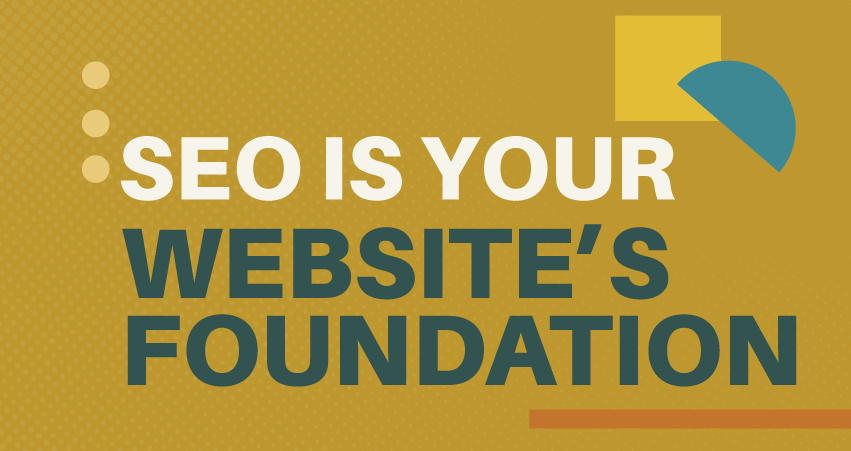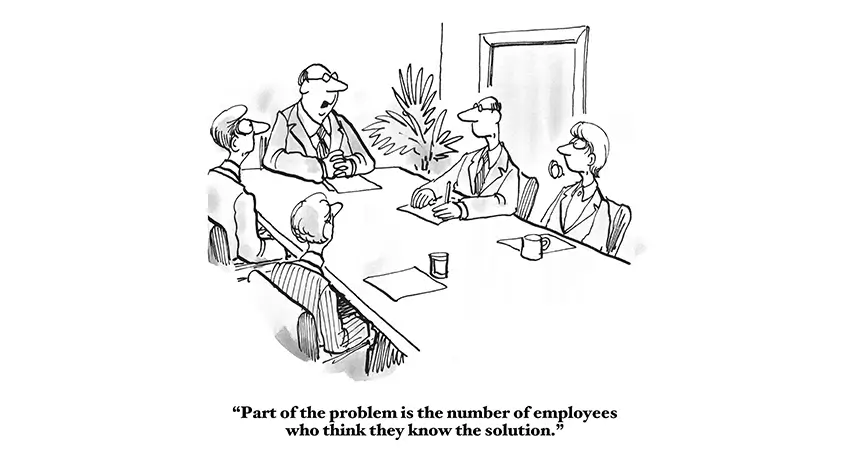SEO Is Your Website’s Foundation, Not a Coat of Paint

In a previous gig, I managed the SEO of a national retail chain. E-commerce division, or the salt mines, where meetings were a small part of the day and not four-fifths.
Every department grew except mine. Design expanded from 2 to 15 workers. Merchandising from 15 to 40. Coders from 0 to 3. And directors from 0 to 6.
SEO remained a department of 1.
Never mind that online revenue followed the same arc as organic traffic. SEO came last, like a coat of paint on a new house with no floor plan.
Why, oh why, was SEO such an afterthought? I had my theories and suspicions.
- For the head of design, SEO was a nuisance. All that text detracted from the pretty images! Plus, who cared about the slow page load time of the awesome 8MB home page? It loaded just fine in the office!
- C-suite executives never liked hearing that their latest marketing project might cost the site half its traffic. They knew best! That’s why they occupied the C-suites (while I shared a cubicle).
- Rank-and-file employees couldn’t be bothered. They were digital marketers only by accident or cruel necessity. Unlike the SEO Department of 1, they left the office before the cleaning crew arrived.
- The CEO didn’t get it. The brand drove the traffic! It couldn’t be the SEO nebbish in the shared cubicle!
Forgive me if I sound bitter.
But without an SEO foundation, your website is doomed. You have nothing to build on other than a heap of preferences, habits, territorial markings, and opinions. Try constructing your e-commerce edifice on that.
SEO (search engine optimization) should precede any page build, content initiative, navigation change, or website redesign. It should always come first — and last.
SEO Building Block #1: Keyword Research
Keyword research guides everything from taxonomy, or the categories you create, to content development and navigation.
What’s good for SEO is also good for customers. Most Google searches are requests for information, services, or shopping. Customers think in terms of keywords and intuitively understand keyword logic and hierarchy.
Keyword research should inform your site structure, the content you develop, and even the anchor text (link text) on the global navigation bar.
SEO Building Block #2: Site Architecture & Taxonomy
Thanksgiving, Hanukkah, and Christmas are holidays. No one acts surprised when you organize them under the Holiday Parties category.
But what if you change “Holidays” to “Celebrations” and place the link next to “Birthdays?” Customers will be lost. How will they find Santa suits, except through internal search (if it works)?
The example may sound far-fetched, but I fought this battle with the lead artist of a high-dollar agency.
In her proposal, she replaced a logical and search-optimized taxonomy with “feel-good” categories that no one understood.
This came on the heels of several focus group sessions. Focus groups are glorified surveys; they’re helpful for branding and general feedback but not much else.
On the other hand, analytics, click data, and keyword research paint a clear picture of customer interest, behavior, and intent and are a much better starting point for a website redesign and reorganization.
Without pushback from SEO, the redesign would have been a disaster — not only for organic traffic but also for UX (the user experience).
The site had several thousand categories. Good luck finding them in a jumble of misguided nomenclature.
SEO Building Block #3: Content Development
“Content” includes everything from the products listed in categories to blogs, menu pages, information pages, videos, and photos.
SEO’s role is to:
- Research the keywords and understand search intent.
- Identify areas of opportunity.
- Recommend topics for new content.
- Optimize existing content (if possible) and align it with search intent.
- Optimize metadata and headings.
- Ensure proper indexing.
- And more.
The research tells you:
- What kind of content to develop.
- How much content to develop.
- What type of content matches search intent: blog, product category page, menu page, or video?
Early in my tenure, the company launched a major content initiative. Months of planning preceded it. Endless meetings.
The CEO weighed in with his opinions, the VP with hers, the Director of Design, the recently hired Director of Content, the department directors…
Everyone had a voice. Except for SEO and UX.
Predictably, the resulting pages were impossible to navigate, and nothing ranked due to flawed template design, weak or non-existent internal linking, and poor page organization.
The content, meant to drive traffic and promote the brand, became a traffic drain, as company siphoned traffic from valuable e-commerce pages to promote it. Traffic moved in the wrong direction, opposite to the master plan.
The content might have succeeded had SEO been involved from the start. As it was, it had no chance.
SEO Building Block #4: Internal Linking & Navigation
Google uses links to crawl the web and understand the relationship between pages on your site. Your website’s internal linking (from one page to another) is crucial for SEO.
Navigation encompasses everything from the global navigation bar at the top of the home page to breadcrumbs, category pages, and product links. It includes site search results, links in blog posts, and even social media sharing.
SEO’s role is to:
- Ensure that all pages are crawlable and indexable.
- Give the most important pages the lion’s share of “link juice.”
- Control outbound links so page authority and link juice aren’t diluted.
- Recommend new internal linking opportunities.
- Optimize existing links and anchor text.
- Reclaim “orphaned” pages with no links pointing to them.
- Fix broken links.
- Redirect deleted pages to new pages.
- And more.
A site with poorly managed internal linking will struggle to rank.
Overlinking is a problem because it overwhelms site visitors and dilutes “link juice.”
Underlinking is also a problem. Customers may not be able to navigate your site. Google may not find and index all your pages, which means they won’t rank.
Most internal linking issues are easy to correct unless your template is defective beyond repair.
Surprise, surprise! We had such a problem on the ol’ retail site, where the preferred category template linked to products via uncrawlable JavaScript, not HTML. Worse, the category pages had no direct links pointing to them from other categories, only redirects.
The templates slowly strangled site SEO, and not until we moved to a new platform were we able to correct a deadly internal linking design.
SEO Building Block #5: Technical SEO
SEO’s technical role is to:
- Create and manage site taxonomy (or advise on it).
- Inspect code for potential SEO problems.
- Ensure that the site is crawlable and indexable.
- Advise on new template design.
- Enter JIRAs to correct coding errors, internal linking problems, etc.
- Submit sitemaps to Google and Bing.
- Manage the redirect database.
- Resolve duplicate content issues.
- Ensure proper use of structured data.
- Optimize site speed.
- And more.
Technical SEO can be complex, but the goal is always to make it easy for Google to understand your content and match it with relevant searches.
Much of the SEO work on a large e-commerce site is technical, from submitting JIRAs for site and code changes to checking for errors and creating redirects.
I once spent two months writing JIRAs for a new platform, three weeks cleaning up site taxonomy on the new platform, four weeks identifying URL changes and creating 35,000 or so redirects, and two weeks on another set of redirects for a site redesign only four months later.
Yeah, it was fun.
SEO Building Block #6: User Experience (UX)
User experience (UX) is a broad term encompassing everything from site design to customer service.
Good UX makes it easy for visitors to find what they’re looking for and accomplish their goals.
SEO’s role is to:
- Make the site easy to use and navigate (or offer insights and advice).
- Ensure that content is relevant and valuable.
- Optimize page load speed.
- Optimize the site for mobile display, not just desktop.
- Reduce visitor frustration (no broken links, bad redirects, etc.).
- And more.
For an example of UX done wrong, let’s return to the failed content initiative mentioned in building block #3.
Late in the project, SEO analyzed visitor click behavior on top-level menu pages.
The featured “inspirational” kids’ birthday content placed high on the home page drew almost no interest. Most customers bounced, and the few who remained scrolled to the bottom to click on baby shower or wedding text links.
Keyword research had shown that weddings and baby showers were the two most promising areas for content development. Yet the company continued to force-feed customers a diet of themed birthdays while hiding the information they wanted.
SEO Building Block #7: Local SEO
Local SEO is a specialized form of SEO that helps businesses rank in local search results.
SEO’s role is to:
- Claim, verify, and optimize your Google Business Profile.
- Create a Bing Business profile.
- Create listings with backlinks in local directories.
- Ensure that your NAP (name, address, and phone number) is consistent across the web.
- Build citations.
- Generate or encourage customer reviews.
- Create content for local audiences.
- Target locally relevant keywords.
- Place local schema on localized pages.
- And more.
Local SEO has less to do with your website than does traditional keyword-based SEO. Still, localized content, local schema, and accurate NAP (name, address, and phone number) on your website are important factors in local rank.
Conclusion
Search engine optimization is a complex and ever-evolving field.
To succeed, you need a solid understanding of how search engines work, what people are searching for, and how to reach your target audience. You should be up-to-date on industry trends and Google algorithm changes.
Above all, you should consider SEO at the outset of any design process or content initiative, not last, when the horse has already left the barn.
Good luck! And please call us at Culture Cube if you need help beyond this humble blog.
About Culture Cube Digital Marketing
Culture Cube specializes in digital marketing for local businesses. Our clients include plumbers, HVAC installers, appliance repair companies, and local newspapers.
We offer the expertise of a large agency at small agency rates.
Because we specialize, we’re better qualified to promote your small business and create the most effective campaigns.
We don’t waste client money on lavish offices, fancy equipment, costly business trips, and endless meetings. We pass our savings on to you and welcome you as a partner more than a client.

Peter Losh is the SEO Director of Culture Cube Marketing in Upland, California. He's also a de facto UX designer, site builder, and content creator. Unlike most folks in the SEO biz, he works directly on the sites he optimizes, having witnessed the effects of recommendations that go ignored or misunderstood (in previous gigs).
Peter has worked on websites since the salad days of the internet, first as a graphic artist and web designer at the Centers for Disease Control. Then came several years of freelance web development, SEO and e-commerce management for business sites of various sizes, and ultimately a 10-year stint as the sole SEO Manager of PartyCity.com.
In his spare time, he enjoys classic film, classical music, and classic comebacks. And cats.
Professional Work Experience
- Search engine optimization
- Ecommerce management
- Conversion rate optimization
- UX design and analysis
- Copywriting and training
- E-mail campaign design
- Web design and development
- Graphic design



